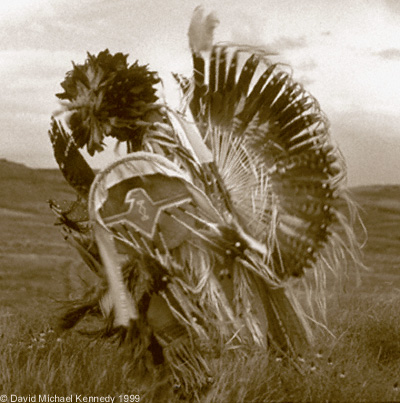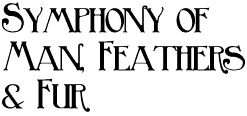July 30, 1999
Press Articles :: Pasatiempo Magazine
Reprinted from Pasatiempo Magazine July 30-August 5 1999
|
|
 |
|
|
|
|
|
Eagle feathers swirl as the Native American dancer moves to ancient rhythms. The spectacle and the feeling of the event capture David Michael Kennedy's soul and the photographer works his own magic to freeze the moment. Kennedy's road to such experiences has been a long one. He tuned his art during 18 years as a professional photographer in New York City, shooting for Time and Rolling Stone. During that time, he photographed Bob Dylan, Isaac Stern, Bruce Springsteen, Mickey Mantle and Muddy Waters and shot album covers for Willie Nelson and Julian Lennon. Although he long has been sympathetic toward Native Americans, his interest came to a head while on an assignment for Penthouse magazine to photograph Leonard Peltier at Leavenworth Prison. "Most people laugh about work for Penthouse but (publisher) Bob Guccione has championed some really important issues and I probably did my most important work for them," Kennedy said in an interview at his home off Highway 14. "Leonard was illegally imprisoned for the murder of an FBI agent and he's been in prison now for 27 years, I think. Meeting and spending time with him somehow pulled me in and I began meeting other Native Americans." In 1991, four years after Kennedy moved to New Mexico, the seed of his passion was sown when a Lakota elder named Severt Young Bear invited him to photograph dancers at a Lakota cultural convention on the Pine Ridge Reservation in South Dakota. After that, Kennedy wanted to shoot a portfolio of dancers in the Eight Northern Indian Pueblos. "That took two years to get going because many of these dances can't normally be photographed and I had to get approvals from the Eight Northern Pueblos Council and each pueblo governor," Kennedy said. "The first time, I photographed a dancer without permission, and took the print and the negatives to the governor. He was upset at first but I told him what I wanted to do and said if he didn't agree, he could keep my negatives." The portfolio published in 1995. Kennedy returned to Pine Ridge to seek permission to photograph Lakota dancers again. "I found a woman named Chic Big Crow, who ran the Sue Ann Boys and Girls Club on the reservation," Kennedy said. "Her daughter, like my own daughter, had died in a car accident. 'When my daughter Tymara died, I did a portfolio on clouds in her memory That blew Big Crow's mind when I told her because she often saw her daughter in the clouds. So we had a connection." Kennedy promised Big Crow he would give a percentage of the sales from his photographs to the Boys and Girls Club if she would help him meet tribal elders, medicine men and dancers. Her contacts led to a series of sessions with selected dancers. "None of these dancers are ever photographed as part of an actual ceremony," Kennedy said. "The dancer and I choose a site and he dances specifically for the photograph." After several visits, the Lakota permitted Kennedy to photograph esoteric subjects usually unavailable to photographers. These included a Ghost Dancer and a Heyoka Dancer (the Heyoka or thunder-dreamer is a Lakota "contrary" who teaches children by doing everything backward). The product of those endeavors, those relationships, is Photographs of American Indian Dancers, opening today, July 30, at Andrew Smith Gallery. The show includes portraits such as a profile of an elderly Steve Charging Eagle; and action shots such as Coyote Dancer Lakota Nation, a motion-charged symphony of man, feathers and fur. Kennedy is known for the warm palladium prints he produces. He mixes his own photosensitive emulsions, brushing them on archival rag papers. He exposes the images like contact prints, using sun- light or a strong ultraviolet light. A saturated solution of potassium oxalate heated to 120 degrees gives the print extra warmth. The process is tedious - a single print may take up to 15 hours to make - and each step has a narrow margin for error. He expends a lot of energy achieving the warm tones. "I like it because it doesn't have the crisp, hard look of silver (emulsions)," he said. "Actually every new project I've ever started I've tried to get away from this brown but I never like (anything else). "I'm doing a series now on the old state penitentiary here, including one of the gas chamber. You'd think those photos would work pretty cold but they're brown too. That's just how I see it and how it feels.' Kennedy points to his portrait work, including blowups of such celebrities as Deborah Harry and Mike Tyson, to illustrate his contention that the brown tones "look more German expressionistic than old-fashioned." Kennedy is pleased Native American groups like his work. One of his photographs appears on a Lakota Sun Dance poster. And activist Russell Means selected a Kennedy landscape for a Wounded Knee victory celebration. A portion of sales from the Andrew Smith show will benefit the Dakota Legal Aid Society and other Native American charities. |
|


